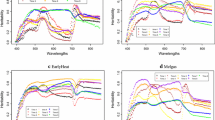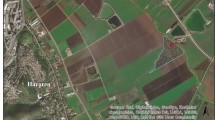Abstract
This study investigated the relationships between sunflower yield and crop multi-temporal spectral data obtained from aerial photographs, land elevation and the presence of Ridolfia segetum weed. Conventional-color and color-infrared airborne photographs were taken at three dates corresponding to the vegetative, flowering and senescent crop stages. Descriptive and statistical methods were applied to every spatial variable to extract the influence of each component on the sunflower yield variability. Principal components and regression models were used to explore the potential of the multi-spectral variables from the airborne photographs to predict the sunflower yield map at every studied date. Higher sunflower yield was found in areas with lower elevation. These areas were also predominantly free of weed infestation. The Normalized Difference Vegetation Index derived from the image taken at crop vegetative stage was strongly correlated to crop yield. A very poor correlation was detected between the sunflower yield and all the multi-spectral variables studied in the flowering and the senescence crop stages. A map with three zones of yield was predicted with 67.81% of overall accuracy using the stepwise-model equation formed by the green and red bands and the two vegetation indices obtained at vegetative crop stage. The selected multi-spectral data taken in early season (mid-May), plus the additional knowledge of weed presence and field elevation, could provide valuable spatial information to estimate the yield crop variability in the studied fields. This estimation might aid in the development of adequate spatially variable management strategies in the months prior to the sunflower harvest.



Similar content being viewed by others
Abbreviations
- Corn caraway:
-
Ridolfia segetum Moris
- Sunflower:
-
Helianthus annuus L
References
Andalusian Government. (2005). Modelo digital del terreno de Andalucía: Relieve y orografía (Digital terrain model of Andalusia: Relief and orography). http://www.juntadeandalucia.es/medioambiente/servtorrent/Modelo_digital_del_terreno_de_Andalucia.Relieve_y_orografia.iso.torrent. Accessed 18 August 2009.
Barros, J. F. C., de Carvalho, M., & Basch, G. (2004). Response of sunflower (Helianthus annuus L.) to sowing date and plant density under Mediterranean conditions. European Journal of Agronomy, 30, 347–356.
Basso, B., Ritchie, J. T., Pierce, F. J., Braga, R. P., & Jones, J. W. (2001). Spatial validation of crop models for precision agriculture. Agricultural Systems, 68, 97–112.
Blackmore, S. (2000). The interpretation of trends from multiple yield maps. Computers and Electronics in Agriculture, 26, 37–51.
Botella-Miralles, O., de Juan-Valero, J. A., & Martín de Santa Olalla, F. (1997). Growth, development and yield of five sunflower hybrids. European Journal of Agronomy, 6, 47–59.
Carranza, P., Saavedra, M., & García-Torres, L. (1995). Competition between Ridolfia segetum and sunflower. Weed Research, 35, 369–375.
Chang, J., Clay, D. E., Dalsted, K., Clay, S., & O’Neill, M. (2003). Corn (Zea mays L.) yield prediction using multispectral and multidate reflectance. Agronomy Journal, 95, 1447–1453.
Congalton, R. G. (1991). A review of assessing the accuracy of classifications of remotely sensed data. Remote Sensing of Environment, 54, 587–592.
Fereres, E., Giménez, C., & Fernández, J. M. (1983). Genetic variability in sunflower cultivars under drought. I. Yield relationships. Australian Journal of Agricultural Research, 37, 573–582.
Flowers, M., Weisz, R., Heiniger, R., Tarleton, B., & Meijer, A. (2003). Field validation of a remote sensing technique for early Nitrogen application decisions in wheat. Agronomy Journal, 95, 167–176.
Foody, G. M. (2002). Status of land cover classification accuracy assessment. Remote Sensing of Environment, 80, 185–201.
Gutiérrez-Peña, P. A., López-Granados, F., Peña-Barragán, J. M., Jurado-Expósito, M., Gómez-Casero, M. T., & Hervás-Martínez, C. (2008). Mapping sunflower yield as affected by Ridolfia segetum patches and elevation by applying evolutionary product unit neural networks to remote sensed data. Computers and Electronics in Agriculture, 60(2), 122–132.
Jackson, R. D., & Huete, A. R. (1991). Interpreting vegetation indices. Preventive Veterinary Medicine, 11, 185–200.
Khosla, R., Inman, D., & Westfall, D. G. (2007). Site-specific management zones: Seven years of research in the irrigated Western Great Plains of the US. In J. Stafford (Ed.), Proceedings of the 6th European conference on precision agriculture (pp. 607–613). The Netherlands: Wageningen Academic Publishers.
Kravchenko, A. N., & Bullock, D. G. (2002). Spatial variability of soybean quality data as a function of field topography: I. Spatial data analysis. Crop Science, 42, 804–815.
Kruse, F. A., Lefkoff, A. B., Boardman, J. B., Heidebrecht, K. B., Shapiro, A. T., Barloon, P. J., et al. (1993). The spectral image processing system (sips)-interactive visualization and analysis of imaging spectrometer data. Remote Sensing of Environment, 44, 145–163.
López-Granados, F., Jurado-Expósito, M., Peña-Barragán, J. M., & García-Torres, L. (2005). Using geostatistical and remote sensing approaches for mapping soil properties. European Journal of Agronomy, 23, 279–289.
López-Granados, F., Jurado-Expósito, M., Peña-Barragán, J. M., & García-Torres, L. (2006). Using remote sensing for identification of late-season grass weed patches in wheat. Weed Science, 54, 346–353.
MAPA. (2006). Spanish ministry of agriculture and fisheries. http://www.mapa.es/es/estadistica/pags/superficie/superficie.htm. Accessed 18 October 2007.
Mercau, J. L., Sadras, V. O., Satorre, E. H., Messina, C., Balbi, C., Uribelarrea, M., et al. (2001). On-farm assessment of regional and seasonal variation in sunflower yield in Argentina. Agricultural Systems, 67, 83–103.
Miao, Y., Mulla, D. J., & Robert, P. C. (2006). Identifying important factors influencing corn yield and grain quality variability using artificial neural networks. Precision Agriculture, 7, 117–135.
Moriondo, M., Maselli, F., & Bindi, M. (2007). A simple model of regional wheat yield based on NDVI data. European Journal of Agronomy, 26, 266–274.
Myneni, R. B., & Williams, D. L. (1994). On the relationship between fAPAR and NDVI. Remote Sensing of Environment, 49, 200–211.
Ortiz, B., Sullivan, D., Perry, C., Vellidis, G., Seymour, L., & Rucker, K. (2007). Delineation of management zones for site-specific management of parasitic nematodos using geostatistical analysis of measured field characteristics. In J. Stafford (Ed.), Proceedings of the 6th European conference on precision agriculture (pp. 615–623). The Netherlands: Wageningen Academic Publishers.
Peña-Barragán, J. M., López-Granados, F., Jurado-Expósito, M., & García-Torres, L. (2006). Spectral discrimination of Ridolfia segetum and sunflower as affected by phenological stages. Weed Research, 46, 10–21.
Peña-Barragán, J. M., López-Granados, F., Jurado-Expósito, M., & García-Torres, L. (2007). Mapping Ridolfia segetum patches in sunflower crop using remote sensing. Weed Research, 47, 164–172.
Pilesjö, P., Thylén, L., & Persson, A. (2005). Topographical data for delineation of agricultural management zones. In J. Stafford (Ed.), Proceedings of the 5th European conference on precision agriculture (pp. 819–826). The Netherlands: Wageningen Academic Publishers.
Ping, J. L., Green, C. J., Bronson, K. F., Zartman, R. E., & Dobermann, A. (2004). Identification of relationships between cotton yield, quality, and soil properties. Agronomy Journal, 96, 1588–1597.
Pinter, P. J., Hatfield, J. L., Schepers, J. S., Barnes, E. M., Moran, M. S., Daughtry, C. S. T., et al. (2003). Remote sensing for crop management. Photogrammetric Engineering and Remote Sensing, 69(6), 647–664.
Plant, R. E. (2001). Site-specific management: The application of information technology to crop production. Computers and Electronics in Agriculture, 30, 9–29.
Pozdnyakova, L., Oudemans, P. V., Hughes, M. G., & Gimenez, D. (2002). Estimation of spatial and spectral properties of phytophthora root rot and its effects on cranberry yield. Computers and Electronics in Agriculture, 37, 57–70.
Rogers, D., Ancev, T., McBratney, A., & Minasny. B. (2007). Incorporating economic criteria into the optimal delineation of management zones. In J. Stafford (Ed.), Proceedings of the 6th European conference on precision agriculture (pp. 851–858). The Netherlands: Wageningen Academic Publishers.
Roudier, P., Tisseyre, B., Poilvé, H., & Roger, J.-M. (2007). Management zone delineation based on remotely-sensed data. In J. Stafford (Ed.), Proceedings of the 6th European conference on precision agriculture (pp. 625–632). The Netherlands: Wageningen Academic Publishers.
Rouse, J. W., Haas, R. H., Schell, J. A., & Deering, D. W. (1973). Monitoring vegetation systems in the Great Plains with ERTS. In S. C. Freden, E. P. Mercanti, & M. A. Becker (Eds.), Proceedings of the earth resources technology satellite symposium (pp. 309–317). Washington DC: NASA SP-351.
Schepers, A. R., Shanahan, J. F., Liebig, M. A., Schepers, J. S., Johnson, S. H., & Luchiari-Jr, A. (2004). Appropriateness of management zones for characterizing spatial variability of soil properties and irrigated corn yields across years. Agronomy Journal, 96, 195–203.
USDA-NRCS. (1998). Keys to Soil Taxonomy (8th ed.). Washington DC: USDA.
Yang, C., Bradford, J. M., & Wiegand, C. L. (2001). Airborne multispectral imagery for mapping variable growing conditions and yields of cotton, grain sorghum, and corn. Transactions of the ASAE, 44, 1983–1994.
Yang, C., & Everitt, J. H. (2002). Relationships between yield monitor data and airborne multidate multispectral digital imagery for grain sorghum. Precision Agriculture, 3, 373–388.
Yang, C., Everitt, J. H., & Bradford, J. M. (2006). Comparison of QuickBird imagery and airborne imagery for mapping grain sorghum yield patterns. Precision Agriculture, 7, 33–44.
Zarco-Tejada, P. J., Ustin, S. L., & Whiting, M. L. (2005). Temporal and spatial relationships between within-field yield variability in cotton and high-spatial hyperspectral remote sensing imagery. Agronomy Journal, 97, 641–653.
Zhang, N., Wang, M., & Wang, N. (2002). Precision agriculture—a worldwide overview. Computers and Electronics in Agriculture, 36, 113–132.
Zhao, D., Reddy, K. R., Kakani, V. G., Read, J. J., & Koti, S. (2007). Canopy reflectance in cotton for growth assessment and lint yield prediction. European Journal of Agronomy, 26, 335–344.
Acknowledgments
This work has been financed by the AGL-2008-04670-CO3-03 project of the Spanish Inter-Ministerial Commission of Science and Technology.
Author information
Authors and Affiliations
Corresponding author
Rights and permissions
About this article
Cite this article
Peña-Barragán, J.M., López-Granados, F., Jurado-Expósito, M. et al. Sunflower yield related to multi-temporal aerial photography, land elevation and weed infestation. Precision Agric 11, 568–585 (2010). https://doi.org/10.1007/s11119-009-9149-6
Published:
Issue Date:
DOI: https://doi.org/10.1007/s11119-009-9149-6




